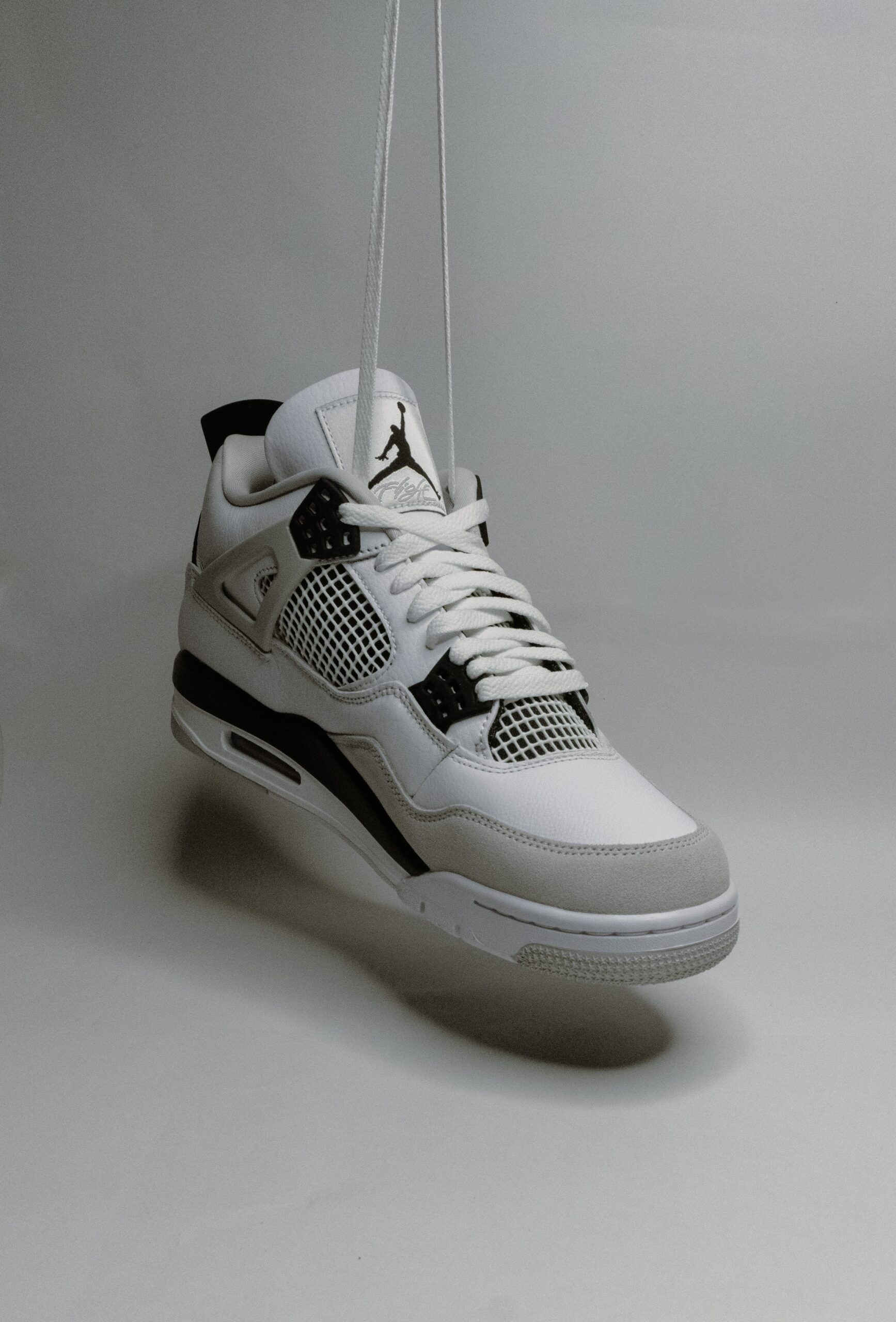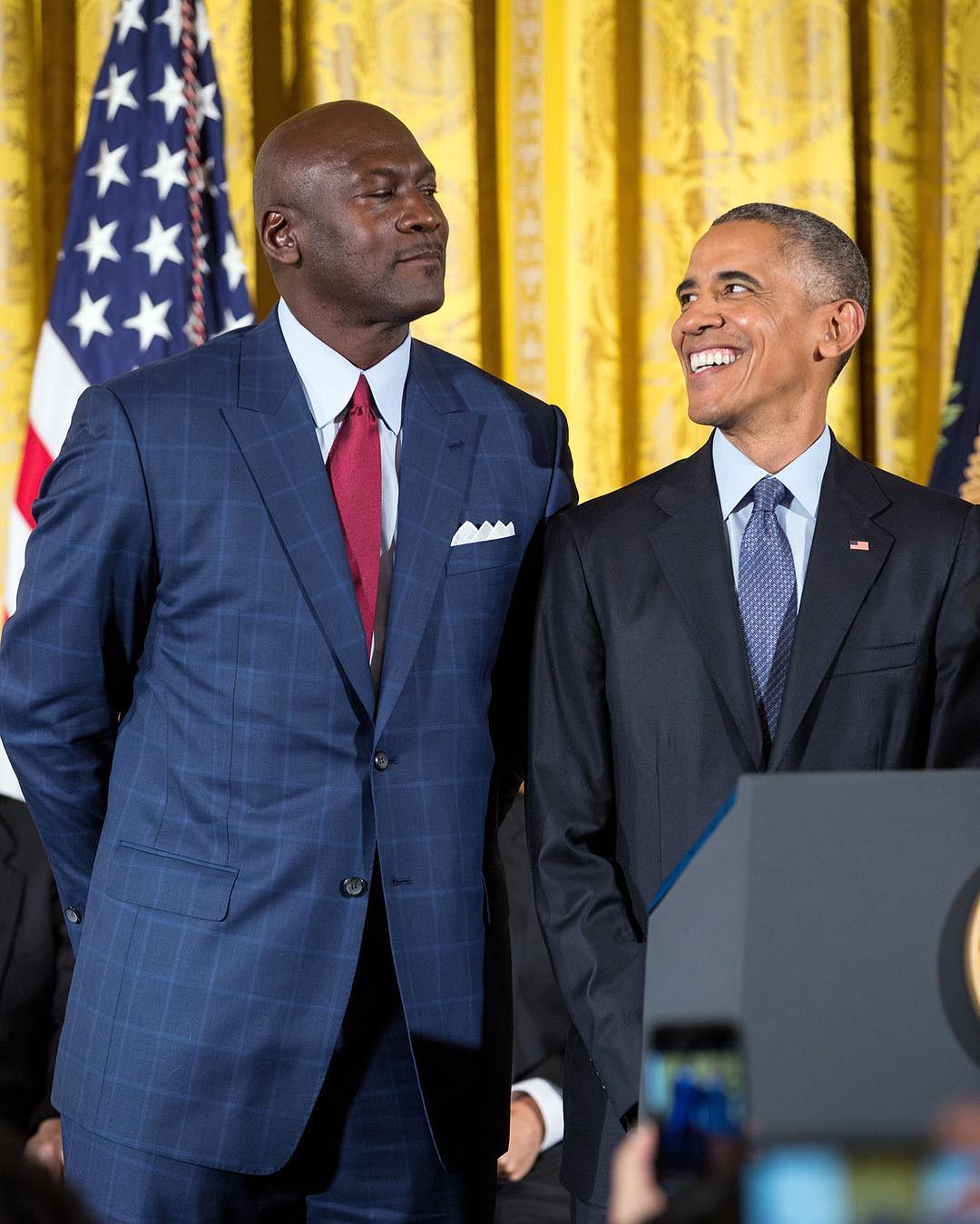History of Air Jordans

Air Jordan is a signature brand of shoes produced by Nike. The first ever Air Jordan was created exclusively for Michael Jordan in 1984. When it was released to the public in 1985, it became one of the most popular basketball shoes ever. Today, there are a total of thirty-two Air Jordan designs in the market and to further learn about how each design was created, here is the history the Air Jordans.
Air Jordan I
The Air Jordan I was designed by Peter Moore for Michael Jackson in 1984. However, the NBA banned the use of the Air Jordan because it did not meet the league’s strict policies on uniforms and colors. But MJ still wore them causing him to pay a fine of five thousand dollars per game. Nike recognized it as a unique marketing strategy that’s why they willingly paid the fine for MJ. The Air Jordan I was the only one in the series which featured the Nike Swoosh logo. It was released on the market from 1985 to 1986.
Air Jordan II
Due to the success of the Air Jordan I, Nike decided to release a new Air Jordan in 1986 for the new basketball season. The Air Jordan II was designed by Bruce Kilgore, the same man who designed Nike’s Air Force One. It was produced in Italy. The Air Jordan II was the first Nike shoe which doesn’t have the familiar Swoosh logo. The word “Nike” was placed across the top of the heel counter and the Wings logo was on the tongue. It was originally retailed at $100. MJ only got to wear the Air Jordan II for 18 games because of a broken foot. Its new edition included a full-length Air-Sole unit which provided extra cushioning for MJ’s sore feet.
Air Jordan III
The Air Jordan III was designed by Tinker Hatfield and was released in 1988. Its rollout included TV ads depicting the actor/director Spike Lee as Mars Blackmon, the character he played in the film, “She’s Gotta Have It”. It sparked series of catchphrases heard around the sneaker world. The AJ III was the first in the Jordan series to feature the Nike AIR logo which was placed at the back. However, it was later replaced by the Jumpman logo with the word AIR under it. The shoe has a sculpted midsole, a visible air unit, and a padded tongue and collar. The AJ III was said to be MJ’s favorite shoes. When it was introduced in 1994, it had poor sales, but when it was reintroduced in 2001, they sold really well.
Air Jordan IV
After the success of the Air Jordan III, Tinker Hatfield designed another one which is the Air Jordan IV. This is the second appearance of the Jumpman logo on the tongue and there was the word “Flight” below it. The sculpted midsole and the visible air unit, as well as the padded tongue collar was carried over to it from the AJ III. For the first time, the AJ IV featured mesh which increased the shoe’s breathability. Nike retro’d the AJ IV in 1999, ten years after its original release and it immediately sold out.
Air Jordan V
The Air Jordan V was again designed by Tinker Hatfield. This Air Jordan was a statement of Michael Jordan’s aggressive nature on the court. It was released on February 1990 for $125. It has a shark tooth design on the outer midsole. Some of its elements were carried from the AJ IV. But it had new features as well such as a reflective tongue, translucent rubber soles, and lace locks. The AJ V was also used in the popular sitcom, The Fresh Prince of Bel-Air. In its many episodes, Will Smith can be spotted wearing the metallic, silver, grape, and fire red colorway. In 2013, Michael Jordan released the Air Jordan 5 Bel Air to pay tribute to Will Smith’s character.
Air Jordan VI
The Air Jordan VI was another design by Tinker Hatfield and was released in 1991. It was the shoe which Michael Jordan wore to the first championship of the Chicago Bulls. The AJ VI had leather overlays which revealed the numbers 2 and 3 to honor MJ’s uniform number. It has two holes on the tongue and a molded heel tab on the back of the sneaker which was demanded by MJ to avoid hurting his Achilles tendon. The AJ VI was also the last Air Jordan to feature the Nike AIR logo. It was also the first shoe used by Hanamichi Sakuragi in the series Slam Dunk. In 2014, Nike released special versions of the AJ VI from the series such as Sakuragi’s number 10 embroidered on the side of the heels.
Air Jordan VII
The Air Jordan VII was released in 1992. Tinker Hatfield drew inspiration from the West African tribal art in creating the AJ VII, giving it bold lines on the midsole. It also had a neoprene inner body to improve its comfort and fit, and making it the lightest basketball shoes at that time. The AJ VII no longer had the visible air sole, translucent outsole, and the famous Nike Air logo. Michael Jordan wore it at the 1992 Summer Games in Barcelona.
Air Jordan VIII
The Air Jordan VIII was released in 1993. It was also designed by Tinker Hatfield. It was noticeably heavier than the other Air Jordans before it, because it has a lot more details like the two crossover straps on each shoe and a jumpman. It has a full length air sole, polyurethane midsole, and poly carbonate shank plate for added support and a more customized fit.
Air Jordan IX
The Air Jordan IX was also released in 1993, after Michael Jordan retired. It was the first Air Jordan which the man himself wouldn’t wear in any basketball competition. That time, Nike prepared the AJ IX to be introduced without MJ. During the 1993 to 1994 season, Penny Hardaway, Kendall Gill, BJ Armstrong, and Mitch Richmond each wore an exclusive version of the shoe. A senior high school named LeBron James also wore the AJ IX to honor his school St. Vincent-St. Mary in Ohio. Its upper part is made of leather, nubuck, and mesh. It also introduced the one-pull lacing system.
Air Jordan X
The Air Jordan X was released in 1994. Michael Jordan returned to the NBA on March 19, 1995. There, he wore the Air Jordan X with the Chicago colorway. The AJ X has a very simple design. It has clean lines and lightweight cushioning. It has an original steel version which had a stitched toe piece but MJ did not like it that’s why all the following colorways of the AJ X had a clean toe cap. It has eight original colorways which are, steel, powder blue, shadow, Chicago, Orlando, New York, Sacramento, and Seattle. It has become one of the most sought-after Air Jordans. In fact, the Chicago colorway has sold thousands of dollars online.
Air Jordan XI
The Air Jordan XI was released in 1995 with the price of $125. Because of its innovative design, it became one of the most loved sneakers ever, particularly the Concord colorway. Tinker Hatfield used patent leather in creating the shoe because it was stronger and fulfilled MJ’s desire to have a shoe that can we worn with a suit. It also has a carbon fiber shank which made it lighter and stronger than any of the previous Air Jordans. In the movie Space Jam, Michael Jordan wore its Black, Varsity Royal, and White version.
Air Jordan XII
Tinker Hatfield drew inspiration from a woman’s fashion shoe and the Japanese flag in creating the Air Jordan XII. It has a rich leather upper which resembles a rising sun. Its toe and accent overlays was comprised with artificial reptile leather. It has the slogan TWO 3 down the tongue, metal lace loops with Jumpman logos, and a pull tab that reads, “Quality inspired by the greatest player ever” which run up the entire heel. It was also the first Air Jordan to feature an ultra-responsive Zoom Air unit and lateral and medial support panels making it one of the most durable shoes in the signature series.
Air Jordan XIII
The Air Jordan XIII was released to the public on November 1, 1997. The Black Panther was Tinker Hatfield’s inspiration for it. Its soles resemble the pads on a Panther’s paw. Its most prominent feature was the hologram on its upper part which resembled the eye of the panther. The AJ XIII also had Zoom Air in the heel, and a Phylon lightweight foam midsole. These made it possibly the most comfortable shoes in the Air Jordan series.
Air Jordan XIV
For the Air Jordan XIV, Tinker Hatfield’s inspiration was Michael Jackson’s Ferrari 550M. It was introduced during the 1998 NBA finals and it was the last shoe MJ wore as a Chicago Bull. The AJ XIV featured a Ferrari-like shield with the Jumpman logo. There was a total of 14 Jumpman logo per pair. They are visible on the side heel, outside sole, insole, back heel, toe, and on the metal lace tips.
Air Jordan XV
On January 13, 1999, Michael Jackson announced his retirement. Once again, Tinker Hatfield was challenged to design an Air Jordan which MJ would never wear on the court. He drew inspiration from the X-15 fighter plane. Like its inspiration, the Air Jordan XV featured an aggressive and sharp-edged silhouette. The heel counter of the shoes featured numbers 23, 6, and 15, which are significant in MJ’s career such as his jersey number, the number of titles he won, and the shoe model.
Air Jordan XVI
The Air Jordan XVI was designed by Wilson Smith III, Nike’s senior footwear designer and was released in 2001. The inspirations where Smith drew the design were from marching boots, high-performance automobiles, and architecture. The shoe featured the return of the clear rubber sole from AJ V, VI, and XI, as well as the patent leather from AJ XI. It was considered one of the most stylish off-court Air Jordans. Michael Jordan wore it with a suit for ads back in 2001.
Air Jordan XVII
The Air Jordan XVII was also designed by Wilson Smith III and was released in 2002. It has a midsole which provided a sturdy and stable framework for the shoe. It comes in a metal briefcase and a CD-ROM was also included which contained the Air Jordan XVII song. Because of this, it was tagged as the most expensive Air Jordan at that time with a suggested retail price of $200. Michael Jordan wore the AJ XVII when he returned to the court.
Air Jordan XIX
The Air Jrdan XIX was designed by several designers such as Tate Kurbis, Jason Mayden, Wilson Smith III, Josh Heard, and Suzette Henri. Their design was inspired by the Black Mamba snake, and it was released in 2004. It featured lightweight and supportive Tech Flex material on the upper which makes it the lightest and most breathable Air Jordan to date.
Air Jordan XX
Tinker Hatfield retook the reins to design the commemorative Air Jordan XX which was released in 2005. The design of the AJ XX was inspired by bicycle shoes. Its strap was placed over the laces in the center of the shoes. The design also helped in creating a tighter fit and an increase support. Some of the pros who wore the AJ XX in the 2004 to 2005 season were Ray Allen and Carmelo Anthony.
Air Jordan XXI
D’Wayne Edwards designed the Air Jordan XXI. The design was inspired by sport touring vehicles. It embodies a premium and elegant style. It features double-over lasted Phylon midsole, lower foot air grilles, a carbon-fibre shank plate, and a seamless diamond quilted booty. It also features an Independent Podular Suspension Technology (IPS) where the wearer could choose between Zoom Air or encapsulated Air cushioning in the heel. It was originally released in 2006.
Air Jordan XX2
The Air Jordan XX2 was also designed by D’Wayne Edwards and was released in 2007. He drew inspiration from the F-22 Raptor fighter jet which has an aggressive and sharp designs. It also has an interchangeable IPS suspension system, a metallic mesh for ventilation, a camouflage pattern, and a traction system which is based on an army general’s stripes. There were two models of AJ XX2 that were released. The first one was for Michael Jordan’s birthday on February 17, which featured authentic Jordan brand basketball leather. The other one was the Omega model which featured a laser-etched image of MJ after he won his 6th NBA championship in 1998.
Air Jordan XX3
Tinker Hatfield teamed up with Mark Smith in designing the Air Jordan XX3. It was the first basketball shoe to incorporate the Nike Considered construction system, which was developed to reduce waste and use environmental friendly materials in making shoes. The AJ X3’s design included MJ’s initials stitched on the upper of each colorway. It also has the lowest midsole of all the Air Jordans. Twenty-three pairs of the Titanium Air Jordan XX3 were released at the top 23 locations in the United States on January 25, 2008 with the price of $230 each.
Air Jordan 2009
The iconic Air Jordan brand continued after the Air Jordan XX3 but it transitioned away from the numbered system and the following Air Jordans were named after the year they were released. The Air Jordan 2009 was designed by Jason Mayden and he drew inspiration from Michael Jordan’s defensive focus and from the sport of fencing. It was the second Air Jordan to use the Nike Considered process. It has a durable pleated silk upper, a carbon fiber arch plate, and Zoom air structure.
Air Jordan 2010
The Air Jordan 2010 was created for the 25th anniversary of Air Jordan. It is also called the Jordan 2010s. It was designed by Tinker Hatfield and Mark Smith. It was released on February 13, 2010 and was endorsed by Dwyane Wade. The base of each midsole of the shoes when combined reads, “I’ve failed over and over again in my life. And that is why I succeeded”. This was a quote attributed to Michael Jordan from an ad which aired in 1997.
Air Jordan 2011
The Air Jordan 2011 was designed by Tom Luedecke. It is technically two shoes in one with the interchangeable insoles, the red “Explosive” one which symbolizes power, and the blue “Quick” one which symbolizes quickness. According to Tom Luedecke, Michael Jordan gave the analogy of a warrior choosing his weapon before going to a battle when referring to the player picking which insole to use.
Air Jordan 2012
Tinker Hatfield and Tom Luedecke teamed up in creating the Air Jordan 2012. The shoe offers six configurations. It has two interchangeable sleeves, and three insoles which adapt to different playing styles. It has a Deluxe model and a Flight model. The Deluxe one was released on February 8, and the Flight model was released on February 25, 2012.
Air Jordan XX8
The Air Jordan XX8 was designed by Tinker Hatfield and Josh Heard. It was released in February 2013. It featured all the cushioning and stability you can expect from an Air Jordan shoe. The difference is that it lived behind a shroud, zippered, which enables the wearer to decide how much to reveal. It also included a molded carbon-fiber external heel counter for added stability.
Air Jordan XX9
The Air Jordan XX9 was released in September 2014 in honor of the Year of the Goat. Tinker Hatfield designed it and it was the lightest ever made in the Air Jordan series. According to Hatfield, it was created in a special weaving machine which creates a web of fibers which is a seamless process. The flexible and sock-like feel of the Air Jordan XX9 came from the strategic panels of lighter and softer flex materials. The shoe was debuted in the NBA by Russel Westbrook and Kawhi Leonard.
Air Jordan XXX
Michael Jordan soaring to the hoop during the 1988 slam dunk contest was what inspired Tinker Hatfield and Mark Smith in creating the Air Jordan XXX. It was released on February 12, 2016. Its upper and outsole were similar to AJ XX9. The only difference in the midsole cushioning from the AJ XX9 is the material used which is plastic instead of carbon fiber for more flexibility.
Air Jordan XXXI
The design of the Air Jordan XXXI was created by Tate Kuerbis. It was highly influenced by the Air Jordan I which has a leather upper and the Nike Swoosh and Jumpman logos, plus a Wings logo as well. It was released on September 3, 2016. The benefits of incorporating the Air Jordan I’s design includes an added ankle support because of the higher top, and the lower midsole puts the foot low to the ground. The AJ XXXI was used by the members of Team USA during the 2016 Olympic basketball tournament.
Air Jordan XXXII
The newest in the Air Jordan series was also designed by Tate Kuerbis. Before he designed the Air Jordan XXXII, he gazed on the past first, specifically on the creation of the Air Jordan II which was made in Italy. According to David Creech, Nike’s Vice President for Design, their goal is to create a distinct design language both on and off court. What’s new about the AJ XXXII is it features a Flyknit upper which is comprised of high-tenacity yarn that combines stretch, support, and zonal lockdown. The release of the Air Jordan XXXII marked the first time Air Jordan was released globally.
More than being a famous signature brand of shoes, it’s amazing to know that the Air Jordan series were inspired by a lot of different things and it took hard work in creating each design. Based on its history, it truly deserved to be one of the well-known brands of shoes in the basketball industry.
Air Jordan XXXIII
Air Jordan has just taken the sneakers game to a higher level with its release of the latest iteration, the XXXIII. What makes the XXXIII unique from its predecessors is that it is the first Air Jordan sneaker to go laceless.
As the news had broken out about its forthcoming release on October 18, 2018, sneaker fans could not contain their curiosity and excitement. Further reports had stated that the Michigan Wolverines would be the first to sport Air Jordan's latest creation on the day of its release, along with other Air Jordan-sponsored teams and players.
The Air Jordan XXXIII is the first sneaker to be equipped with the new FastFit technology, which completely foregoes the use of lace. The sneaker tightens by itself according to the size of your foot. This is going to be a big relief to athletes as they can effortlessly adjust the fit of the shoe to better suit their own different needs. This works somewhat similarly to the HyperAdapt 1.0 but without the laces.
The Air Jordan XXXIII features an oversized tongue and heel section which both have pull tabs. The shoe's upper construction is made of mixed materials which are chosen in a way so that it delivers optimum comfort, durability and performance.
Alright, that's it for the list, I hope you found it helpful!
If you're looking for a complete support combination, you need supportive footwear first. Here are the Best Basketball Shoes for ANKLE SUPPORT.




